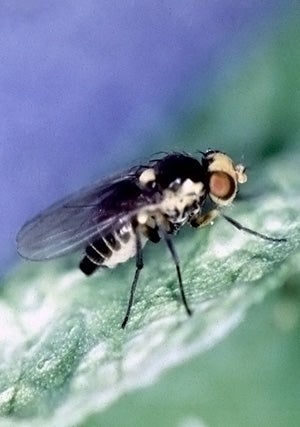Pea Leafminer, Liriomyza huidobrensis
The Situation: A new biotype of the pea leafminer was introduced in Northern California and is expanding rapidly into Central and Southern California. Already this insect has become a major pest of vegetable crops from Monterey to Ventura Counties. It has spread as far north as Placer County and as far south as Las Vegas County. This exotic biotype has become a major economic pest in the past three years in South America, Indonesia, Asia and the Mediterranean Region. Because natural enemies of the pea leafminer have not been effective in suppressing populations, and the biotype has high levels of pesticide resistance, control has been extremely difficult.
Damage: Larvae of the pea leafminer create mines in the foliage and stems of many vegetables. Feeding damage by the larvae reduces the photosynthetic capacity of plants and destroys marketable parts of leafy vegetables. Even a few mines in celery, spinach, or lettuce render the entire plant unmarketable. At high densities, defoliation and further substantial yield losses can occur in other vegetables. In addition feeding and oviposition punctures made by adult females reduce the aesthetic quality of ornamental and cut flowers.
Economic Impact: California produces 55% of the fresh vegetables grown in the United States. Crops attacked by the pea leafminer include peas, lettuce, beans, celery, spinach, broccoli, onions, and many ornamental plants. The coastal counties of Monterey, San Benito, San Luis Obispo, Santa Barbara, and Ventura are leading producers of such crops, with an annual value of $1.5 billion. Control costs for the pea leafminer are approximately $45-$95 per acre per treatment. Multiple generations per crop usually require several treatments. The species ability to rapidly develop pesticide resistance will only increase the economic losses as growers apply additional pesticides in order to achieve some suppression.
Distribution: The new biotype pea leafminer is currently the predominant leafminer pest in the cooler coastal valleys. It has been spreading in predominance over the last few years from the Monterey region to the south. The rate of spread is about 100 miles annually. The expected movement into the warmer San Joaquin and Imperial Valleys will dramatically increase economic losses.
Research: The University of California is examining why the pea leafminer has become such a serious pest within the last decade. Based on molecular evidence, some scientists now believe this insect may be a cryptic species, L. langei. However, adults of L. langei can mate with L. huidobrensis and produce viable offspring, so the designation is uncertain. Regardless, an integrated pest management program is being developed to reduce pesticide impacts on natural enemies of the pea leafminer in California for many vegetable crops. As an interim measure, new pesticide chemistries and resistance management strategies are being evaluated.
Center for Invasive Species Research, University of California Riverside
Text and Photos Provided by: John T. Trumble, Greg Kund and Stewart Reitz
John Trumble, Professor of Entomology
john.trumble@ucr.edu
Personal Website
Greg Kund, Staff Research Associate
gregory.kund@ucr.edu



